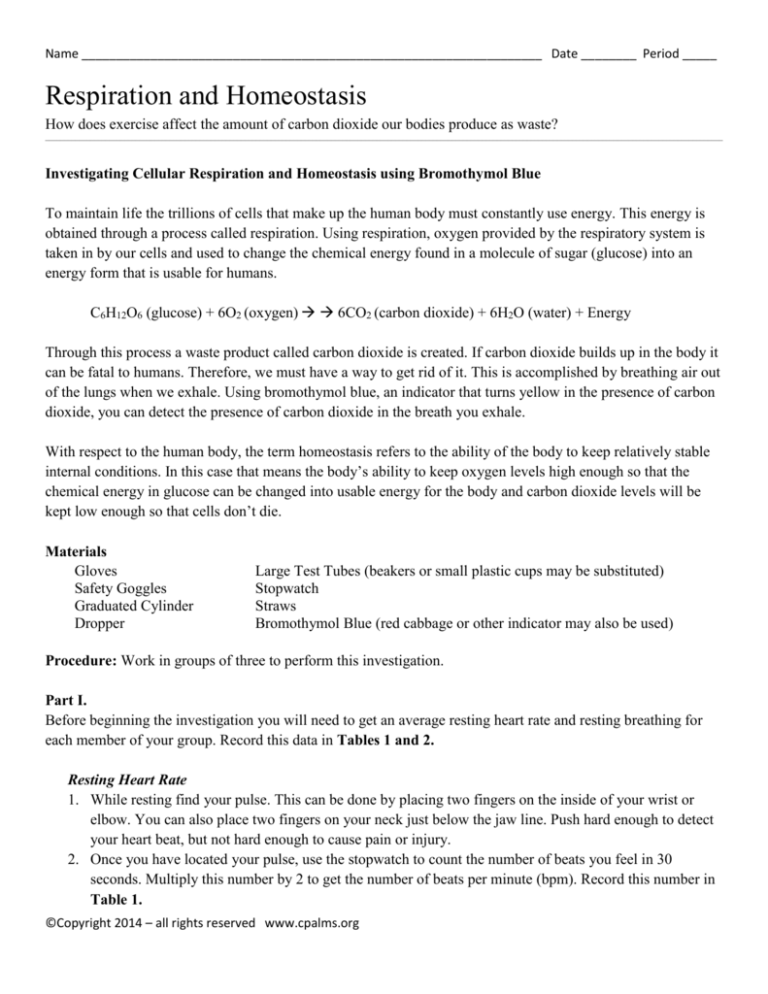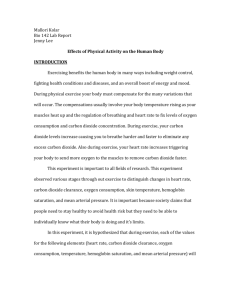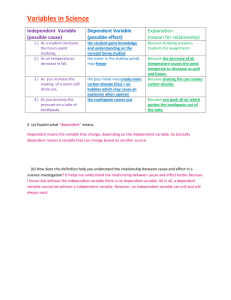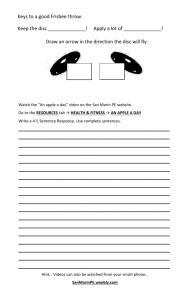
Name ___________________________________________________________________ Date ________ Period _____
Respiration and Homeostasis
How does exercise affect the amount of carbon dioxide our bodies produce as waste?
____________________________________________________________________________________________________________________________________________________________________________________
Investigating Cellular Respiration and Homeostasis using Bromothymol Blue
To maintain life the trillions of cells that make up the human body must constantly use energy. This energy is
obtained through a process called respiration. Using respiration, oxygen provided by the respiratory system is
taken in by our cells and used to change the chemical energy found in a molecule of sugar (glucose) into an
energy form that is usable for humans.
C6H12O6 (glucose) + 6O2 (oxygen) 6CO2 (carbon dioxide) + 6H2O (water) + Energy
Through this process a waste product called carbon dioxide is created. If carbon dioxide builds up in the body it
can be fatal to humans. Therefore, we must have a way to get rid of it. This is accomplished by breathing air out
of the lungs when we exhale. Using bromothymol blue, an indicator that turns yellow in the presence of carbon
dioxide, you can detect the presence of carbon dioxide in the breath you exhale.
With respect to the human body, the term homeostasis refers to the ability of the body to keep relatively stable
internal conditions. In this case that means the body’s ability to keep oxygen levels high enough so that the
chemical energy in glucose can be changed into usable energy for the body and carbon dioxide levels will be
kept low enough so that cells don’t die.
Materials
Gloves
Safety Goggles
Graduated Cylinder
Dropper
Large Test Tubes (beakers or small plastic cups may be substituted)
Stopwatch
Straws
Bromothymol Blue (red cabbage or other indicator may also be used)
Procedure: Work in groups of three to perform this investigation.
Part I.
Before beginning the investigation you will need to get an average resting heart rate and resting breathing for
each member of your group. Record this data in Tables 1 and 2.
Resting Heart Rate
1. While resting find your pulse. This can be done by placing two fingers on the inside of your wrist or
elbow. You can also place two fingers on your neck just below the jaw line. Push hard enough to detect
your heart beat, but not hard enough to cause pain or injury.
2. Once you have located your pulse, use the stopwatch to count the number of beats you feel in 30
seconds. Multiply this number by 2 to get the number of beats per minute (bpm). Record this number in
Table 1.
©Copyright 2014 – all rights reserved www.cpalms.org
Name ___________________________________________________________________ Date ________ Period _____
3. Repeat this two more times.
4. Calculate your average resting heart rate by adding all three resting rates recorded in Table 1 together
and dividing by 3.
5. Record this number in Table 1.
Resting Breathing Rate
1. While resting find your breathing rate.
2. Use the stopwatch to count the number of times you breathe in and out in 60 seconds (one minute). One
inhale plus one exhale equals one breath. Record this number in Table 2.
3. Repeat this two more times.
4. Calculate your average resting breathing rate by adding all three resting breathing rates recorded in
Table 2 together and dividing by 3.
5. Record this number in Table 2.
Part II.
Once both average resting heart and breathing have been recorded for each member of your group you may
begin the investigation.
Carbon dioxide production rate
Each member of the group will perform each of these procedures.
While Resting
1. Label one test tube with your name and the words ‘resting CO2’.
2. Using a graduated cylinder measure 30 ml of water and add it to the test tube you just labeled.
3. Using a dropper carefully add 15 drops of bromothymol blue into the same test tube as the water.
4. Be sure your partner is ready with the stopwatch. Then place a straw into the test tube and exhale (breath
out – DO NOT BREATHE IN).
5. Have a partner time how long (in seconds) it takes for the solution to turn yellow. Record this number in
Table 3.
6. Calculate the group resting carbon dioxide production rate average by adding all three resting carbon
dioxide production rates recorded in Table 3 together and dividing by 3.
7. Record this number in Table 3
STOP, PREDICT, AND EXPLAIN
A. What do you think would happen to the carbon dioxide production rate if you exercised before you
breathed into the test tube? Explain why you think this would happen.
B. Take turns sharing your prediction and explanation with the other members of your group. You do
not have to agree with their ideas, but you may make revisions to your prediction or explanation if
you feel it’s necessary.
©Copyright 2014 – all rights reserved www.cpalms.org
Name ___________________________________________________________________ Date ________ Period _____
After One Minute of Exercise (Increased Energy Demand for Muscle Cells)
1. Label a second test tube with your name and the words ‘CO2 – 1 minute exercise’.
2. Using a graduated cylinder measure 30 ml of water and add it to the test tube you just labeled.
3. Using a dropper carefully add 15 drops of bromothymol blue into the same test tube as the water.
4. Using the stopwatch exercise for one minute by doing jumping jacks or jogging in place.
5. Be sure your partner is ready with the stopwatch. Then place a straw into the test tube and exhale (breath
out – DO NOT BREATHE IN).
6. Have a partner time how long it takes for the solution to turn yellow. Record this number in Table 3.
7. Without resting too much quickly record your heart rate (in seconds) and breathing rates (in seconds,
refer to instructions above if needed) and record those numbers in Table 3.
8. Calculate the average group carbon dioxide production rate after 60 seconds (one minute) of exercise by
adding all three resting carbon dioxide production rates recorded in Table 3 together and dividing by 3.
9. Record this number in Table 3
After Two Minutes of Exercise (Increased Energy Demand for Muscle Cells)
1. Label a third test tube with your name and the words ‘CO2 – 2 minutes exercise’.
2. Using a graduated cylinder measure 30 ml of water and add it to the test tube you just labeled.
3. Using a dropper carefully add 15 drops of bromothymol blue into the same test tube as the water.
4. Using the stopwatch exercise for two minutes by doing jumping jacks or jogging in place.
5. Be sure your partner is ready with the stopwatch. Then place a straw into the test tube and exhale (breath
out – DO NOT BREATHE IN).
6. Have a partner time how long it takes for the solution to turn yellow. Record this number in Table 3.
7. Without resting too much quickly record your heart rate (in seconds) and breathing rates (in seconds,
refer to instructions above if needed) and record those numbers in Table 3.
8. Calculate the average group carbon dioxide production rate after 120 seconds (two minutes) of exercise by
adding all three resting carbon dioxide production rates recorded in Table 3 together and dividing by 3.
9. Record this number in Table 3
Data Collection
Part I.
Table 1: Resting Heart Rate (beats per minute)
Group Member
Trial 1 (bpm)
Trial 2 (bpm)
#1
#2
#3
©Copyright 2014 – all rights reserved www.cpalms.org
Trial 3 (bpm)
Average (bpm)
Name ___________________________________________________________________ Date ________ Period _____
Table 2: Resting Breathing Rate (breaths per minute)
Group Member
Trial 1
Trial 2
Trial 3
Average
#1
#2
#3
Table 3: Carbon Dioxide Production Rates (time in seconds), Heart Rate (bpm), Breathing Rate (breaths per
minute)
Group
What’s Being
Resting
After 1 Minute After 2 minutes
Average
Member
Recorded
Exercise
Exercise
Carbon Dioxide
Production Rate
(in seconds)
#1
Heart Rate (bpm)
Breathing rate
(breaths per minute)
Carbon Dioxide
Production Rate
(in seconds)
#2
Heart Rate (bpm)
Breathing rate
(breaths per minute)
Carbon Dioxide
Production Rate
(in seconds)
#3
Heart Rate (bpm)
Breathing rate
(breaths per minute)
©Copyright 2014 – all rights reserved www.cpalms.org
Name ___________________________________________________________________ Date ________ Period _____
Part II.
Once you have calculated both resting and exercising averages for all members of you group record them on the
class chart.
Analyze
STOP, THINK, AND EXPLAIN
Part I.
A. Describe the changes in carbon dioxide production rates throughout the investigation.
B. Give an explanation for why you think these changes occurred.
C. Take turns sharing your explanations with the other members of your group. You do not have to
agree with their explanations, but you may make revisions to your explanation if you feel it’s necessary.
Part II.
A. Think about how the carbon dioxide production rates changed as you exercised. How do you think
this relates to the explanation of homeostasis given at the beginning of the lab?
B. Take turns sharing your ideas about homeostasis with the other members of your group. You do
not have to agree with their ideas, but you may make revisions to your ideas if you feel it’s necessary.
©Copyright 2014 – all rights reserved www.cpalms.org









